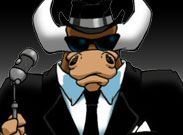John Wayne
Entertainers Home / Entertainment Channel
ALSO: See how Wayne's one-eyed badass Rooster Cogburn fared in our Badass Bracket!
“And come with greet teeth – because, gentlemen, that’s when school really begins.”
– John Wayne, “The Cowboys”
The story of John Wayne is as legendary as the man himself. In the 1950s, he was more than a household name, he was an American landmark – appearing on stamps, lunchboxes, and a regular on the big screen, his 6’4” frame towering over the audiences and setting the record of 142 movies in which he was the star. Struggling to maintain privacy, torn between his passion for acting and devotion to the domestic life, Wayne was vocal on many issues of the day – his conservative stance on Vietnam resulted in 1968’s “The Green Berets,” he desperately lobbied for the role of “Patton” in 1970, and out of his 15 year bout with cancer came the John Wayne Cancer Institute. He was sentimental, traditional, contradictory, and quick to give credit where it was due. Awarded his lone Oscar for “True Grit,” he turned to Richard Burton who was a fellow Best Actor nominee and thrust the statuette to him: “This should be yours,” Wayne said. Such stories abound throughout his life and career. While not associated with the acting titans of his contemporaries – Brando, for example – he is annually ranked at the top of movie star lists, his Westerns achieving classic status, and his characters indelibly American.
Born Marion Morrison in Iowa in 1907, with his family moving to southern California soon after, Morrison played football for a couple of years at USC – his first movie role was as an uncredited Yale football player in “Brown of Harvard” in 1926. He was an extra for more than 15 movies and worked in the prop department in the meantime. It was in 1930 when Morrison was given his first lead role, but not before his name was changed to John Wayne after the urging of “The Big Trail” director Raoul Walsh, who was reading a biography on the Revolutionary War general “Mad” Anthony Wayne at the time. The name stuck.
It was a slow rise for Wayne who was earning his pay in B-Westerns and serials throughout the 1930s. Credit the director John Ford for finally igniting Wayne’s career in 1939’s “Stagecoach.” The actor became Ford’s favorite, and Wayne, knowing he owed his career to the man, adored Ford like a father. Over a span of more than three decades, the two collaborated on almost twenty five movies, some of them American classics such as “The Quiet Man,” “The Searchers,” and “The Man Who Shot Liberty Valance.” Wayne knew he was at home in the Western genre, even directing “The Alamo” himself in 1960.
He was married three times and raised seven children. Developing cancer in the 1960s, Wayne attributed it to the five packs of cigarettes he smoked a day while the acquisition of the disease may possibly be also attributed to radiation exposure following an atomic bomb test in Utah while filming “The Conqueror” in 1955. Of the 220 who worked on the film, 91 contracted cancer. Wayne died in 1979 from the disease at the age of 72. As in life, John Wayne’s legendary screen status continues to remain a classic American image. But perhaps he will be best known as a public cancer victim (producers wanted it kept secret), and the founding of both the John Wayne Cancer Institute in Los Angeles and his family’s establishment of the John Wayne Cancer Foundation. “Give the American people a good cause,” he once said, “and there’s nothing they can’t lick.”
 Tired of striking out? Check out these Dating Tips for all sorts of advice on how to finally get the girl! Also, we tell you all about some of the best online dating sites and how you can use them to hook up with more women!
Tired of striking out? Check out these Dating Tips for all sorts of advice on how to finally get the girl! Also, we tell you all about some of the best online dating sites and how you can use them to hook up with more women!
John on the Web
IMDb
John Wayne’s complete filmography and career-spanning photo gallery.
Wikipedia
Detailed biography including anecdotes and trivia.
Official Site
Duke’s official page.
Roger Ebert’s “True Grit” Review
Ebert’s four star-review is also a nice summation of John Wayne’s impact.
John on the Screen
The Duke’s work with John Ford must first be mentioned – it was really Ford who is responsible for making John Wayne who he became. The first shot of John Wayne in “Stagecoach” is a classic: Wayne steps into the frame and the camera zooms in so fast his face goes out of focus, but Ford left it in. They made a post-Civil War cavalry trilogy together: “For Apache,” “She Wore a Yellow Ribbon,” and “Rio Grande.” The Duke is the Irish boxer in “The Quiet Man,” Ethan Edwards (his favorite role) in “The Searchers,” and he’s opposite Jimmy Stewart and Lee Marvin in “The Man Who Shot Liberty Valance.” Outside the Ford films, he’s Genghis Khan in his least favorite movie “The Conqueror,” The Centurion in “The Greatest Story Ever Told,” Davy Crockett in “The Alamo,” the highest paid star in “The Longest Day,” Sean Mercer in “Hatari!” (Swahili for “danger”), and Rooster Cogburn twice.
The Duke Says
On winning his Oscar:
“If I had known, I would have put that eye patch on 35 years earlier.”
On acting:
“Talk low, talk slow, and don’t talk too much.”
On men:
“If a man says, ‘I'll call you,’ and he doesn't, he didn't forget. . . . he didn't lose your number. . . . he didn't die. He just didn't want to call you.”
To Cary Grant on Christopher Reeve, 1979:
“This is our new man. He's taking over.”








